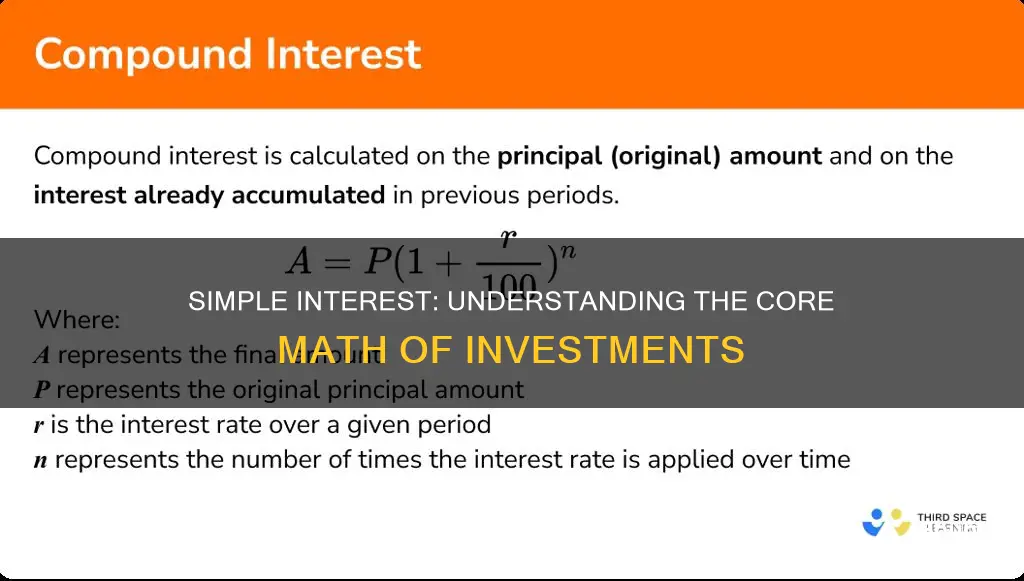
Simple interest is a straightforward method of calculating interest on a loan or deposit. It is based on the initial principal amount, and the interest remains constant throughout the entire term of the loan or investment. When borrowing money, the lender charges interest on the loan. When repaying the loan, the borrower must pay back the initial principal amount along with the interest accrued. The interest is calculated as a percentage of the initial principal, and it does not compound on any previously earned interest.
| Characteristics | Values |
|---|---|
| Definition | A type of interest that is calculated only on the initial amount borrowed/invested, without considering any interest charged/earned in previous periods. |
| Formula | P (principal amount) x R (rate of interest) x T (time) |
| Application | Simple interest is commonly used for short-term loans, such as personal loans or short-term deposits, and is easy to understand and calculate. |
What You'll Learn

Simple interest is calculated only on the initial amount borrowed/invested
Simple interest is a straightforward method of calculating interest on a loan or deposit. It is based on the initial principal amount, and the interest remains constant throughout the entire term of the loan or investment. This means that simple interest is calculated only on the initial amount borrowed or invested. It is a fixed percentage of the principal amount that is charged or earned over a specific period of time.
When borrowing money, the lender charges interest on the loan. When repaying the loan, the borrower must pay back the initial principal amount along with the interest accrued. The interest is calculated as a percentage of the initial principal, and it does not compound on any previously earned interest. This is why simple interest is always applied to the original principal amount, with the same rate of interest for every time cycle.
Simple interest is commonly used for short-term loans, such as personal loans or short-term deposits. It is easy to understand and calculate, making it a popular choice for basic interest calculations. For example, if you borrow £1000 at a 5% interest rate for a year, you will owe £1050 at the end of the year. This is because the interest is calculated as a percentage of the initial £1000, and it does not compound on any previously earned interest.
Simple interest can also be applied to investments. For example, if you invest £1000 in a savings account that earns 5% interest per year, you will have £1050 at the end of the year. Again, the interest is calculated as a percentage of the initial £1000, and it does not compound on any previously earned interest. This means that the rate of interest remains constant throughout the entire term of the investment.
Equity and Interest: Understanding Investment Fundamentals
You may want to see also

The interest remains constant throughout the entire term of the loan or investment
Simple interest is a straightforward method of calculating interest on a loan or deposit. It is based on the initial principal amount, and the interest remains constant throughout the entire term of the loan or investment.
When borrowing money, the lender charges interest on the loan. When repaying the loan, the borrower must pay back the initial principal amount along with the interest accrued. The interest is calculated as a percentage of the initial principal, and it does not compound on any previously earned interest.
Simple interest is calculated using the following formula:
P = Principal amount, which is the initial amount borrowed or invested.
T = Time refers to the duration for which the principal amount is lent or borrowed. It is usually expressed in years or months.
The amount is the money that an individual receives from the borrower, which is the total of the principal and interest amount. It can be expressed as:
Step 1: Identify the principal amount: Determine the initial amount borrowed or invested.
Step 2: Find the interest rate: Identify the interest rate specified as a percentage.
Simple interest is commonly used for short-term loans, such as personal loans or short-term deposits, and is easy to understand and calculate, making it a popular choice for basic interest calculations.
Interest Rate Hike: Impact on Investment Demand and Behavior
You may want to see also

Simple interest is commonly used for short-term loans
When borrowing money, the lender charges interest on the loan. When repaying the loan, the borrower must pay back the initial principal amount along with the interest accrued. Simple interest is easy to understand and calculate, making it a popular choice for basic interest calculations. It is often used for personal loans or short-term deposits.
Simple interest always applies to the original principal amount, with the same rate of interest for every time cycle. The interest applied by banks is of many types, and simple interest is one of them. Loan examples include home loans, car loans, education loans, and personal loans.
Simple interest is calculated using the following formula: P (the principal amount, or initial amount borrowed/invested) and T (the duration for which the principal amount is lent or borrowed, usually expressed in years or months).
Interest Rate Changes: Impact on Planned Investments
You may want to see also

The formula for simple interest
Simple interest is a straightforward method of calculating interest on a loan or deposit. It is based on the initial principal amount, and the interest remains constant throughout the entire term of the loan or investment. When borrowing money, the lender charges interest on the loan. When repaying the loan, the borrower must pay back the initial principal amount along with the interest accrued. The interest is calculated as a percentage of the initial principal, and it does not compound on any previously earned interest.
Simple interest is commonly used for short-term loans, such as personal loans or short-term deposits, and is easy to understand and calculate, making it a popular choice for basic interest calculations. It is calculated by the following formula:
P: Principal amount which is the initial amount borrowed or invested.
T: Time refers to the duration for which the principal amount is lent or borrowed. It is usually expressed in years or months. The amount is the money that an individual receives from the borrower, which is the total of the principal and interest amount. It can be expressed as:
- Identify the principal amount: Determine the initial amount borrowed or invested.
- Find the interest rate: Identify the interest rate specified as a percentage.
- Multiply the principal amount by the interest rate.
- Multiply that number by the number of years the money is borrowed or invested for.
Smart Investments: Higher Interest Options for Your Money
You may want to see also

The future value of an investment
Simple interest is a type of interest that is calculated only on the initial amount borrowed or invested, without considering any interest charged or earned in previous periods. It is a fixed percentage of the principal amount that is charged or earned over a specific period of time. The principal amount is the initial amount borrowed or invested, and the time refers to the duration for which the principal amount is lent or borrowed.
Simple interest is commonly used for short-term loans, such as personal loans or short-term deposits, and is easy to understand and calculate, making it a popular choice for basic interest calculations. When borrowing money, the lender charges interest on the loan. When repaying the loan, the borrower must pay back the initial principal amount along with the interest accrued. The interest is calculated as a percentage of the initial principal, and it does not compound on any previously earned interest.
Simple interest is one of the many types of interest applied by banks. It is a straightforward method of calculating interest on a loan or deposit, and it is commonly used for short-term loans.
Unlocking Compound Interest: Smart Investments for Long-Term Growth
You may want to see also
Frequently asked questions
Simple interest is a straightforward method of calculating interest on a loan or deposit. It is based on the initial principal amount, and the interest remains constant throughout the entire term of the loan or investment.
Simple interest is calculated using the following formula: P (the principal amount which is the initial amount borrowed or invested) x T (the duration for which the principal amount is lent or borrowed).
Simple interest is calculated only on the initial amount borrowed/invested, without considering any interest charged/earned in previous periods.







